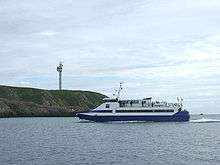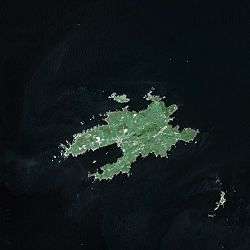Ushant
| Ushant Ouessant, Eusa | ||
|---|---|---|
| Commune | ||
|
Satellite image of Ushant in 2003 | ||
| ||
 Ushant | ||
|
Location within Brittany region  Ushant | ||
| Coordinates: 48°27′29″N 5°05′44″W / 48.4581°N 5.0956°WCoordinates: 48°27′29″N 5°05′44″W / 48.4581°N 5.0956°W | ||
| Country | France | |
| Region | Brittany | |
| Department | Finistère | |
| Arrondissement | Brest | |
| Canton | Saint-Renan | |
| Government | ||
| • Mayor (2014–2020) | Denis Palluel | |
| Area1 | 15.58 km2 (6.02 sq mi) | |
| Population (2008)2 | 856 | |
| • Density | 55/km2 (140/sq mi) | |
| Time zone | CET (UTC+1) | |
| • Summer (DST) | CEST (UTC+2) | |
| INSEE/Postal code | 29155 /29242 | |
| Elevation |
0–61 m (0–200 ft) (avg. 30 m or 98 ft) | |
| Website | Official website | |
|
1 French Land Register data, which excludes lakes, ponds, glaciers > 1 km² (0.386 sq mi or 247 acres) and river estuaries. 2 Population without double counting: residents of multiple communes (e.g., students and military personnel) only counted once. | ||
Ushant (/ˈʌʃənt/;[1] Breton: Eusa, pronounced [ˈøsa]; French: Ouessant, pronounced [wɛsɑ̃]) is an island at the south-western end of the English Channel which marks the north-westernmost point of metropolitan France. It belongs to Brittany and is in the traditional region of Leon. Administratively, Ushant is a commune in the Finistère department. It is the only place in Brittany, except the name Brittany itself, with a separate name in English.
Geography
The island is ringed by several smaller islands, including Keller Island (Île de Keller) and Kadoran (Île Cadoran) to the north. The 200-meter (660 ft) channel between Ushant and Keller is called the Toull C'heller.
Ushant marks a southern limit of the Celtic Sea[2] and the southern entrance to the western English Channel, the northern entrance being the Isles of Scilly, southwest of Land's End in Cornwall, England. Although it is sometimes considered an island in the English Channel, it does not form part of the Channel Islands. According to the definitions of the International Hydrographic Organization the island lies outside the English Channel and is in the Celtic Sea.[3]
The island is a rocky landmass some 8 km (5.0 mi) by 3 km (1.9 mi) with a total area of 15 km2 (5.8 sq mi).
History
Ushant is famous for its maritime past, both as a fishing community and as a key landmark in the Channel approaches. It is named in the refrain of the sea shanty "Spanish Ladies":
"We'll rant and we'll roar like true British sailors,
We'll rant and we'll roar across the salt seas,
Until we strike soundings in the channel of old England,
From Ushant to Scilly 'tis thirty-five leagues."
Several naval battles have been fought near Ushant between the British and French navies.
During World War II, a force of British Commandos and US Army Rangers of the 29th Provisional Rangers successfully attacked a German radar installation on the island.[4]
In March 1978, the oil tanker Amoco Cadiz ran aground at Portsall about 19 miles (31 km) from the island, leading to major pollution of the Brittany coast.
According to an old Breton proverb, "Qui voit Molène voit sa peine / Qui voit Ouessant voit son sang / Qui voit Sein voit sa fin" ("He who sees Molène sees his pains / He who sees Ushant sees his blood / He who sees Sein sees his end"). This proverb is related to the area around the island, considered one of the most challenging to navigate in the world with its many rocks and more than ten knot tide streams.
A standard start and finish line for circumnavigations of the Earth is between Ushant and Lizard Point.
Population
There is only one significant community on the island: the village of Lambaol (Lampaul).
| Historical population | ||||||||||||||||||||||||||||||||||||||||||||||||||||||||||||||||||||||||||||||||||||||||||||||||||||||||||||||
|---|---|---|---|---|---|---|---|---|---|---|---|---|---|---|---|---|---|---|---|---|---|---|---|---|---|---|---|---|---|---|---|---|---|---|---|---|---|---|---|---|---|---|---|---|---|---|---|---|---|---|---|---|---|---|---|---|---|---|---|---|---|---|---|---|---|---|---|---|---|---|---|---|---|---|---|---|---|---|---|---|---|---|---|---|---|---|---|---|---|---|---|---|---|---|---|---|---|---|---|---|---|---|---|---|---|---|---|---|---|---|
|
|
| ||||||||||||||||||||||||||||||||||||||||||||||||||||||||||||||||||||||||||||||||||||||||||||||||||||||||||||
Sights
The Creac'h lighthouse (Phare du Creach) is reputedly the most powerful in the world.
Events
In 2007, Ushant hosted a Scottish book festival and subsequently created their own tartan;[5] and in August 2010, the islanders were reported to be seeking to establish cultural links with a Scottish island. Rob Gibson, Member of the Scottish Parliament for the Highlands and Islands welcomed the opportunity.[6]
Transport

Ushant is connected to the French mainland by both air and sea. Passenger ferries of the Penn Ar Bed company operate from Brest and Le Conquet year-round, and also from Camaret in summer, stopping at the island of Molène en route.[7] The airline Finistair operates flights on Cessna 208 planes from Brest Bretagne Airport.[8]
Fauna
The Ouessant sheep is a rare breed originating from Ushant. It is one of the northern European short-tailed sheep group of breeds, a type ubiquitous in northern Europe up to Roman times, but which now survives only in a few places. Apart from Ushant, these are remote islands and mountains of Britain and Scandinavia and some places around the Baltic Sea. The Ouessant is one of the smallest breeds of domestic sheep. It is usually black or dark brown (a few are white), and it is now kept elsewhere in the world as a heritage breed.
The isolation of the island has helped the conservation of the Apis mellifera mellifera dark bee, unaffected by pollution, pesticides and Varroa parasites.[9] In the rest of France it has been substituted by Apis mellifera ligustica. As a side effect, the Braula coeca,[10] that has elsewhere perished by the anti-Varroa treatments, can still be found among the Ushant bees. The association Conservatoire de l'Abeille Noire Bretonne[11] tries to develop this bee race intending to reintroduce it in Western France.[12]
Literary references

"Lord Ushant" is the title given the heir to the Duchy of Tintagel (Cornwall) in Edith Wharton's The Buccaneers (1938).
Ushant is also the title of the autobiography of the American poet and novelist Conrad Aiken, published in 1952.
Ushant is mentioned in George Orwell's diaries, in passing.[13]
Ushant is also a character briefly appearing in Herman Melville's White-Jacket. Ushant is highly admired for his beard. See chapter 84 of the book for further information.
Ushant is mentioned repeatedly in the works of Patrick O'Brian in reference to the maritime activities and position of various ships and characters in the series.
Ushant appears occasionally as a landfall in C. S. Forester's novels about Horatio Hornblower.
Ushant is one of the locations in the mystery Act of Mercy by Peter Tremayne. The book is set in 666 A.D.
Ushant is the setting of the 2004 French film L'Équipier (English title: The Light) directed by Philippe Lioret.
Father Truitard, a character in Bruce Chatwin's novel The Viceroy of Ouidah, spent "years communing with the waves and petrels on the island of Ushant".
Ushant is mentioned in Dmitry Lukhmanov's narrative 20 000 miles under sail.[14]
It's also mentioned in Le Sang de la sirène (The Blood of the Siren, 1901) by Anatole Le Braz.
A ship from Ushant (Ouessant in French) is mentioned in the poem Barbara by French poet Jacques Prévert. Rudyard Kipling mentions it in his poem Anchor Song.
Ushant hands out annual Ouessant island literary prizes worldwide.[15]
Yann Tiersen recorded his album, Eusa (2016). Every track is named after places of Ushant.
In a 1971 novella, 'Überfahrt. Eine Liebesgeschichte,' by East German writer Anna Seghers, Ushant is mentioned towards the end of an Atlantic sea crossing from Brazil to East Germany. A character quotes in German the proverb 'Whoever sees Ushant sees their blood.' English translation - 'Crossing: A Love Story' by Anna Seghers, translated by Douglas Irving (USA: Diálogos Books, 2016), p. 154
The story of a 1910 novel Das Meer by German author Bernhard Kellermann is taking place on the island of Ushant. Many features of the island, such as Phare du Creach and Port du Stiff are described in details, while the main character is staying at the la Villa des tempêtes, which is in ruins today.
See also
- Battle of Ushant (disambiguation)
- Communes of the Finistère department
- Parc naturel régional d'Armorique
- List of the works of Charles Cottet depicting scenes of Brittany
References
- ↑ "Definition of "Ushant" - Collins English Dictionary". collinsdictionary.com. Retrieved 29 November 2015.
- ↑ C. Michael Hogan. 2011. Celtic Sea. eds. P.saundry & C.Cleveland. Encyclopedia of Earth. National Council for Science and the /environment. Washington DC.
- ↑ "Limits of Oceans and Seas, 3rd edition + corrections" (PDF). International Hydrographic Organization. 1971. pp. 42 [corrections to page 13]. Retrieved 25 September 2010.
- ↑ Slaughter, John Robert (8 November 2009). Omaha Beach and Beyond: The Long March of Sergeant Bob Slaughter. Zenith Press. pp. 70–71. ISBN 9780760337349.
- ↑ "French island of Ouessant adopts local tartan". BBC News. 10 August 2010.
- ↑ "Islanders Seek Scots Friends". The Herald. Glasgow. 16 August 2010.
- ↑ "Bateau vers les iles Ouessant, Molène et Sein - Penn Ar Bed". pennarbed.fr (in French). Retrieved 29 November 2015.
- ↑ "Bienvenue sur www.finistair.fr - Compagnie Finist'air". finistair.fr (in French). Retrieved 29 November 2015.
- ↑ Alle, Gérard; Le Moigne, Jean-Louis (2011). Abeille et miel en Bretagne (in French). Coop Breizh. ISBN 9782843465222.
- ↑ Martin, Jean-Pierr. "Braula cœca" (in French).
- ↑ Dominique Raizon (4 April 2012). "L'Abeille Noire d’Ouessant est en pleine forme" (in French). Radio France Internationale. Retrieved 29 November 2015.
- ↑ "L'abeille noire réintègre le continent". espace-sciences.org (in French). Retrieved 29 November 2015.
- ↑ "September 3, 1938". Orwell Diaries 1938-1942. Retrieved 29 November 2015.
- ↑ "Жизнь моряка (fb2)". rus.ec (in Russian). Retrieved 29 November 2015.
- ↑ Bloom, Dan (13 May 2015). "Translation of eco-fantasy book wins French island prize". Taipei Times. Retrieved 29 November 2015.
External links
| Wikimedia Commons has media related to Ouessant. |
- (in French) Ushant communal council website
- (in French) Cultural Heritage
- INSEE
- Article at AllRefer Encyclopedia, based on The Columbia Electronic Encyclopedia
- Traditional, "Spanish Ladies", credited to Iron Men & Wooden Ships, by Frank Shay
- Ile d'Ouessant - Photo gallery
- Storm Island – article about the island by William Langewiesche in the December 2001 issue of The Atlantic

